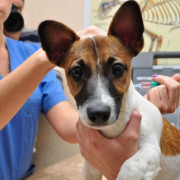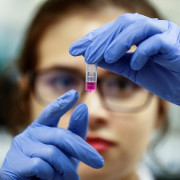Коронавирус: особенности инфекции, диагностика и лечение
Содержание:
- Лопинавир + Ритонавир (Lopinavir + Ritonavir)
- Infection prevention and control
- После поездки с повышенным риском пройдите тест и оставайтесь дома
- References
- ПОДДЕРЖИВАЮЩАЯ ТЕРАПИЯ ПРИ COVID-19
- Description of indicators
- Safety
- Routes of transmission
- Indiana’s Novel Coronavirus Response
- Сопутствующие патологии
- How to order the Real-Time Reverse Transcriptase (RT)-PCR Diagnostic Panel
- Specimen Types
- Интенсивная терапия у взрослых с COVID-19. Рекомендации ESICM
- COVID-19 and nutrition for health
- Схема лечения Covid-19
- Ordering Supplies (For Clinical Laboratories)
- Animals that can be infected with the virus that causes COVID-19
Лопинавир – антиретровирусный препарат II поколения, ингибирующий вирусную протеазу ВИЧ. В комбинации с Ритонавиров, который является противовирусным препаратом и назначается в низких дозировках с целью потенцирования эффекта Лопинавира, у ВИЧ-инфицированных больных, при СПИДе, отмечается улучшение состояния, а также снижается показатель смертности.
На основании опыта лечения SARS COV, при котором использовали Лопинавир + Ритонавир в комбинации с Рибавирином (Ribavirin), специалисты полагают, что эта комбинация является перспективным средством для терапии коронавирусной инфекции (однако, клинические данные об использовании этих препаратов ограничены, несмотря на постоянное их увеличение в последние месяцы).
Утверждение о клинической эффективности Лопинавир + Ритонавира основано на поступающих данных. Аналогично, случайно собранная информация показывает, что применение Лопинавир + Ритонавира позволяет снизить вирусную нагрузку COVID-19 в довольно короткие сроки.
В данный момент ученые проводят рандомизированное контролируемое клиническое исследование MIRACLE, в котором проверяется терапевтический эффект комбинации Лопинавир + Ритонавир + Интерферон-β-1b (Interferon-β-1b) у больных с MERS-CoV (Ближневосточный респираторный синдром).
Infection prevention and control
Rates of SARS-CoV-2 infection in neonates do not appear to be affected by mode of delivery, method of infant feeding, or contact with a mother with suspected or confirmed SARS-CoV-2 infection. All neonates born to mothers with suspected or confirmed infection should be considered as having suspected SARS-CoV-2 infection when test results are not available.
In general, mothers with suspected or confirmed SARS-CoV-2 infection and their neonates should be isolated from other healthy mothers and neonates and cared for according to recommended infection prevention and control practices for routine healthcare delivery. If a neonate does not remain in the mother’s room, facilities should consider the institution’s capacity and resources as well as the potential risk of SARS-CoV-2 transmission to other high-risk neonates when determining where the neonate should be isolated.
Isolating infants with suspected or confirmed SARS-CoV-2 infection in a Neonatal Intensive Care Unit (NICU) should be avoided unless the neonate’s clinical condition warrants NICU admission. Locating neonates with suspected or confirmed SARS-CoV-2 infection in a NICU may unnecessarily increase the risk of exposing other vulnerable infants and NICU staff to SARS-CoV-2. In some hospitals, a NICU may be the only suitable environment for appropriate care of an isolated neonate. Therefore, determination about best placement should be made at the facility level.
После поездки с повышенным риском пройдите тест и оставайтесь дома
Прохождение теста до и после поездки может снизить риск распространения COVID-19
Прохождение теста не устраняет все риски, однако в сочетании с периодом самоизоляции на дому и мерами предосторожности, такими как ношение защитной маски и социальное дистанцирование, тестирование может сделать путешествия более безопасными, уменьшив распространение инфекции в самолетах, аэропортах и в местах назначения путешественников
Если во время международной поездки Вы участвовали в видах деятельности с повышенным риском, выполняйте действия, перечисленные выше, И после поездки выполните следующее:
-
Пройдите тест через 3–5 дней после поездки И оставайтесь дома в течение 7 дней после поездки.
- Даже если результат Вашего теста отрицательный, оставайтесь дома в течение полных 7 дней.
- Если результат Вашего теста положительный, самоизолируйтесь, чтобы защитить других от заражения.
- Если Вы не будете проходить тест, безопаснее всего в течение 10 дней после поездки оставаться дома.
- Избегайте в течение 14 дней находиться рядом с людьми, которые подвержены повышенному риску заболевания тяжелой степени, независимо от того, будете Вы проходить тест или нет.
Постоянно следуйте рекомендациям или требованиям штата и местной администрации, относящимся к поездкам.
Виды деятельности, связанные с повышенным риском
Ниже перечислены некоторые виды деятельности, которые повышают риск заражения COVID-19:
- Возвращение из страны или территории США, получившей 2-го уровня, 3-го уровня или 4-го уровня.
- Посещение крупных общественных мероприятий, таких как свадьба, похороны или вечеринка.
- Посещение массовых собраний, таких как спортивные мероприятия, концерты или парады.
- Пребывание в людных местах, например в ресторанах, барах, фитнес-центрах или кинотеатрах.
- Поездки в общественном транспорте, например в поездах или автобусах, или нахождение в транспортных узлах, например в аэропортах.
- Путешествие на круизном судне или речном катере.
Что делать, если Вы заболели после поездки или у Вас положительный результат теста
Если Вы заболели и у Вас наблюдается повышение температуры, кашель или другие симптомы COVID-19 или у Вас положительный результат теста:
Оставайтесь дома и принимайте другие меры предосторожности. Избегайте контактов с другими людьми, пока не закончите безопасную домашнюю изоляцию.
Не путешествуйте, когда Вы больны.
Возможно, у Вас COVID-19
Большинство людей могут выздороветь дома без медицинской помощи.
Общайтесь со своим врачом. Позвоните, прежде чем идти в кабинет врача или отделение неотложной помощи, и сообщите, что у Вас может быть COVID-19.
Если у Вас появился (включая затрудненное дыхание), немедленно обратитесь за неотложной медицинской помощью.
Если Вы живете в тесном контакте с другими людьми, примите дополнительные меры предосторожности, чтобы защитить их.
Если у Вас запланирован прием у врача, который нельзя отложить, позвоните в кабинет врача и скажите, что Вы заражены или возможно заражены COVID-19. Это поможет защитить сотрудников офиса и других пациентов. Дополнительная информация представлена на веб-странице Центра по контролю и профилактике заболеваний США (CDC) «Что делать, если Вы заболели».
References
- Arons MM, Hatfield KM, Reddy SC, Kimball A, James A, Jacobs JR, et al. Presymptomatic SARS-CoV-2 infections and transmission in a skilled nursing facility. N Engl J Med 2020 May 28;382(22):2081-2090. doi:10.1056/NEJMoa2008457.
- Bullard J, Durst K, Funk D, Strong JE, Alexander D, Garnett L et al. Predicting Infectious SARS-CoV-2 From Diagnostic Samples. Clin Infect Dis 2020 May 22. doi: 10.1093/cid/ciaa638.
- Cheng HW, Jian SW, Liu DP, Ng TC, Huang WT, Lin HH, et al. Contact Tracing Assessment of COVID-19 Transmission Dynamics in Taiwan and Risk at Different Exposure Periods Before and After Symptom Onset. JAMA Intern Med 2020 May 1; doi:10.1001/jamainternmed.2020.2020.
- Kiyuka PK, Agoti CN, Munywoki PK, Njeru R, Bett A, Otieno JR, et al. Human Coronavirus NL63 Molecular Epidemiology and Evolutionary Patterns in Rural Coastal Kenya. J Infect Dis 2018 May 5;217(11):1728-1739. doi: 10.1093/infdis/jiy098.
- Korea Centers for Disease Control and Prevention. Findings from Investigation and Analysis of re-positive cases. May 19, 2020. Available at: https://www.cdc.go.kr/board/board.es?mid=a30402000000&bid=0030&act=view&list_no=367267&nPage=1external icon
- Li N, Wang X, Lv T. Prolonged SARS-CoV-2 RNA Shedding: Not a Rare Phenomenon. J Med Virol 2020 Apr 29. doi: 10.1002/jmv.25952.
- Liu WD, Chang SY, Wang JT, Tsai MJ, Hung CC, Hsu CL, et al. Prolonged Virus Shedding Even After Seroconversion in a Patient With COVID-19. J Infect 2020 Apr 10;S0163-4453(20)30190-0. doi: 10.1016/j.jinf.2020.03.063
- Lu J, Peng J, Xiong Q, Liu Z, Lin H, Tan X, et al. Clinical, immunological and virological characterization of COVID-19 patients that test re-positive for SARS-CoV-2 by RT-PCR. (Preprint) Medrxiv. 2020. Available at: https://www.medrxiv.org/content/10.1101/2020.06.15.20131748v1external icon doi: https://doi.org/10.1101/2020.06.15.20131748
- Midgley CM, Kujawski SA, Wong KK, Collins, JP, Epstein L, Killerby ME et al. (2020). Clinical and Virologic Characteristics of the First 12 Patients with Coronavirus Disease 2019 (COVID-19) in the United States. Nat Med 2020 Jun;26(6):861-868. doi: 10.1038/s41591-020-0877-5.
- Quicke K, Gallichote E, Sexton N, Young M, Janich A, Gahm G, et al. Longitudinal Surveillance for SARS-CoV-2 RNA Among Asymptomatic Staff in Five Colorado Skilled Nursing Facilities: Epidemiologic, Virologic and Sequence Analysis. (Preprint) Medrxiv. 2020. Available at: https://www.medrxiv.org/content/10.1101/2020.06.08.20125989v1external icon doi: https://doi.org/10.1101/2020.06.08.20125989external icon
- van Kampen J, van de Vijver D, Fraaij P, Haagmans B, Lamers M, Okba N, et al. Shedding of infectious virus in hospitalized patients with coronavirus disease-2019 (COVID-19): duration and key determinants. (Preprint) Medrxiv. 2020. Available at: https://www.medrxiv.org/content/10.1101/2020.06.08.20125310v1external icon doi: https://doi.org/10.1101/2020.06.08.20125310
- Wölfel R, Corman VM, Guggemos W, Seilmaier M, Zange S, Müller MA, et al. (2020). Virological assessment of hospitalized patients with COVID-2019. Nature 2020 May;581(7809):465-469. doi:10.1038/s41586-020-2196-x
- Xiao F, Sun J, Xu Y, Li F, Huang X, Li H, et al. Infectious SARS-CoV-2 in Feces of Patient with Severe COVID-19. Emerg Infect Dis 2020;26(8):10.3201/eid2608.200681. doi:10.3201/eid2608.200681
- Young BE, Ong SWX, Kalimuddin S, Low JG, Ta, SY, Loh J, et al. Epidemiologic Features and Clinical Course of Patients Infected With SARS-CoV-2 in Singapore. JAMA 2020 Mar 3;323(15):1488-1494. doi:10.1001/jama.2020.3204
- Personal communication with Young BE first author of preprint of: Young BE, Ong SW, Ng LF, Anderson DE, Chia WN, Chia PY, et al. Immunological and Viral Correlates of COVID-19 Disease Severity: A Prospective Cohort Study of the First 100 Patients in Singapore. (Preprint) SSRN. 2020. Available at: https://papers.ssrn.com/sol3/papers.cfm?abstract_id=3576846external icon http://dx.doi.org/10.2139/ssrn.3576846
- Zou L, Ruan F, Huang M, Liang L, Huang H, Hong Z, et al. (2020). SARS-CoV-2 Viral Load in Upper Respiratory Specimens of Infected Patients. N Engl J Med, 382(12), 1177-1179. doi:10.1056/NEJMc200173
ПОДДЕРЖИВАЮЩАЯ ТЕРАПИЯ ПРИ COVID-19
Имеющиеся данные дают основания полагать, что стероидная терапия не дает преимуществ с точки зрения клинического исхода при лечении коронавирусной инфекции, и может оказать обратный эффект – замедление выведения вируса. При этом, у больных с острым респираторным дистресс-синдромом, не инфицированных коронавирусом, отмечается положительное влияние при введении низких доз Дексаметазона в течение ограниченного периода (10 дней) и позволяет снизить смертность. Учитывая косвенность имеющихся доказательств, клиницисты считают необходимым целесообразность изучения вопроса использования Дексаметазона при остром респираторном дистресс-синдроме по показаниям интенсивности.
Доказано, что неинвазивная вентиляция легких при лечении пневмонии, обусловленной коронавирусной инфекцией, обуславливает ухудшение течения патологии. Поэтому Всемирная организация здравоохранения рекомендует, по мере возможности, избегать неинвазивную вентиляцию легких, а использовать раннюю эндотрахеальную интубацию (см статью «COVID-19: Восстановление проходимости дыхательных путей. Эндотрахеальная Интубация»). В случае необходимости проведения неинвазивной вентиляции легких, процедура должна выполняться в отделении интенсивной терапии.
Description of indicators
The following are core and secondary indicators for decision makers to consider when deciding to open, close, or reopen schools over time. The core indicators include measures of underlying community transmission as well as a measure of adherence to key mitigation strategies.
Core indicators
Core indicators include one or both measures of community burden AND one self-assessed measure of school implementation of key mitigation strategies. Additional information including how to calculate these indicators is found in the table below.
Measures of community burden
- The number of new cases per 100,000 persons within the last 14 days, AND/OR
- The percentage of RT-PCR tests that are positive during the last 14 days, AND
Implementation of mitigation strategies
- The school’s ability to adhere to the following key mitigation strategies
- Consistent and correct use of masks
- Social distancing to the extent possible
- Hand hygiene and respiratory etiquette
- Cleaning and disinfection
- Contact tracing in collaboration with local health department
Schools should adopt the additional mitigation measures outlined below to the largest extent possible, practical and feasible.
Secondary indicators
Additionally, we provide secondary indicators that officials can use to support the decision-making process in local communities. These secondary indicators should not be used as the main criteria for determining the risk of disease transmission in schools. They should be used to support decision-making derived from the core indicators.
For example, knowing the percentage of hospital beds and intensive care unit beds occupied in a local hospital, including the percentage of inpatient beds occupied by a patient with COVID-19, can indicate the severity of illness in the community and whether the health care system can serve more patients. Similarly, the identification of a community outbreak indicates increased community transmission and, therefore, elevated risk of the introduction and subsequent transmission in schools.
Safety
How do I report it if I have a problem or bad reaction after getting a COVID-19 vaccine?
CDC and FDA encourage the public to report possible side effects (called adverse events) to the Vaccine Adverse Event Reporting System (VAERS)external iconexternal icon. This national system collects these data to look for adverse events that are unexpected, appear to happen more often than expected, or have unusual patterns of occurrence. Learn about the difference between a vaccine side effect and an adverse event. Reports to VAERS help CDC monitor the safety of vaccines. Safety is a top priority.
Healthcare providers will be required to report certain adverse events following vaccination to VAERS. Healthcare providers also have to adhere to any revised safety reporting requirements according to FDA’s conditions of authorized use throughout the duration of any Emergency Use Authorization; these requirements would be posted on FDA’s websiteexternal iconexternal icon.
CDC is also implementing a new smartphone-based tool called v-safe to check-in on people’s health after they receive a COVID-19 vaccine. When you receive your vaccine, you should also receive a v-safe information sheet telling you how to enroll in v-safe. If you enroll, you will receive regular text messages directing you to surveys where you can report any problems or adverse reactions you have after receiving a COVID-19 vaccine.
What does it mean if a clinical trial is temporarily paused?
Safety is a top priority during the vaccine approval process. It is not unusual for a clinical trial to be temporarily paused when a possible side effect (called an adverse event) is detected. Clinical trials are designed to pause when an unexpected health event (called a safety signal) is detected so scientists and physicians can investigate potential safety concerns. The approval process for COVID-19 vaccines is no different ― safety is always the focus.
Routes of transmission
Transmission of SARS-CoV-2, the virus that causes COVID-19, to neonates is thought to occur primarily through respiratory droplets during the postnatal period when neonates are exposed to mothers or other caregivers with SARS-CoV-2 infection. Limited reports in the literature have raised concern of possible intrauterine, intrapartum, or peripartum transmission, but the extent and clinical significance of vertical transmission, which appears to be rare, is unclear. At this time, there are insufficient data to make recommendations on routine delayed cord clamping or immediate skin-to-skin care for the purpose of preventing SARS-CoV-2 transmission to the neonate.
The Indiana Department of Health is closely monitoring a pandemic of the 2019 novel (new) coronavirus or COVID-19. This new respiratory virus was first identified in the city of Wuhan in China’s Hubei Province and continues to infect people in China and around the world, including the United States.
On March 6, the state Department of Health confirmed the first case of COVID-19 in a Hoosier with recent travel. On March 16, ISDH reported the first death in Indiana due to COVID-19. On May 18, Indiana confirmed its first case of multisystem inflammatory syndrome in children (MIS-C) that has been associated with COVID-19.
The dashboard below will be updated daily with the most up-to-date case counts. Please click here for the most recent press releases related to COVID-19.
The state Department of Health is working with federal and local partners, including the Centers for Disease Control and Prevention (CDC), to respond to this evolving public health situation.
Please consult this page for updated news and guidance on the COVID-19 pandemic. Updates will be made as new information becomes available. Please contact your healthcare provider if you experience symptoms of COVID-19 including fever, cough, shortness of breath, fatigue, muscle or body aches, headache, new loss of taste or smell, sore throat, congestion or runny nose, nausea or vomiting, and diarrhea. Symptoms may appear 2-14 days after exposure to the virus. Please immediately seek care if you experience symptoms such as trouble breathing, persistent pain or pressure in the chest, new confusion, inability to wake or stay awake and bluish lips or face.
General questions from the public or healthcare provider inquiries about COVID-19 may be directed to the state Department of Health COVID-19 Call Center at the toll-free number: 877-826-0011 (8 a.m. to 5 p.m. daily for public and healthcare providers).
Important Information
- Commissioner’s Order: Statewide Standing Order for the Administration of Vaccines by Other Providers (updated 12/17/20)
- Commissioner’s Order: Statewide Protocol and Appendix for the Administration of Vaccines by Other Providers (updated 12/17/20)
- COVID-19 Indiana County Guidelines by Color (updated 12/10/20)
- Executive Order 20-50: Executive Order 20-50: Continuation of County-based Measures and Restrictions Based on the Impact and Spread of the Coronavirus Disease
- Commissioner’s Order: Statewide Standing Order for the Administration of Vaccines (updated 10/01/20)
- Commissioner’s Order: Indiana Statewide Standing Order to Address the COVID-19 Outbreak (updated 4/30/2020)
- Commissioner’s Order: Concerning Relocation of LTC Facility Residents during the COVID-19 Outbreak (updates 4/14/20)
- Watch Governor Holcomb’s next COVID-19 briefing (updated 10/14/20)
- Commissioner’s Order: Requirements for Reporting COVID-19 Information to the State Department of Health (updated 6/01/20)
- See Governor Eric J. Holcomb’s Newsroom
- COVID-19 Resource Guide for Hoosiers Looking for Assistance (updated 9/02/20)
- Department of Workforce Development Resource Page (updated 3/16/2020)
Tweets by StateHealthIN
Сопутствующие патологии
Отметим, что анализ данных исследований клинико-эпидемиологических характеристик у 41 пациента, инфицированных коронавирусом, продемонстрировал прогностическую значимость наличия сопутствующих патологий. Так, из общего количества исследуемых (n = 41), сахарный диабет был у 8 больных (20%), гипертоническая болезнь – у 6 (15%), заболевания сердечно сосудистой системы – у 6 пациентов (15%). 13 больных (32%) прошли интенсивную терапию (искусственная вентиляция легких), обусловленную дыхательной недостаточностью и гипоксемией, но на данный момент вопрос смертности от коронавируса полностью не изучен.
Опыт эпидемии атипичной пневмонии (SARS) в 2003 году оказался очень полезным в борьбе с пандемией коронавирусной инфекции COVID-19.
How to order the Real-Time Reverse Transcriptase (RT)-PCR Diagnostic Panel
The International Reagent Resource (IRR)external icon is distributing the diagnostic panel and supplies to registered state and local public health laboratories so they can perform SARS-CoV-2 testing.
During the SARS-CoV-2 pandemic, state public health laboratories can authorize county or city laboratories in each state to perform testing. These laboratories must be certified under the Clinical Laboratory Improvement Amendment (CLIA) to perform high-complexity tests, have appropriate laboratory equipment and training, and demonstrate testing proficiency under their state laboratory’s stewardship to maintain their status as an IRR-registered laboratory. The IRR does not supply clinicians, hospitals, or healthcare professionals with testing kits directly. Clinicians, hospitals, and healthcare professionals should refer to the list of commercially available lots of primers and probespdf icon that are acceptable alternatives to the CDC-provided reagents. The list begins on page 7 in the authorized CDC 2019-nCoV Real-Time RT-PCR Diagnostic Panel Instructions for Useexternal icon Package Insert.
Specimen Types
Are stool specimens appropriate for SARS-CoV-2 viral testing?
Stool specimens do not have Emergency Use Authorization (EUA) approval and thus are not acceptable for SARS-CoV-2 viral testing. Although data are limited, they indicate that stool might not be an appropriate specimen. Stool specimens are less sensitive than respiratory specimens, and SARS-CoV-2 RNA is often detected later during COVID-19 illness. Therefore, testing stool early in illness could potentially lead to false negative SARS-CoV-2 viral test results. Also, even though viral tests have detected SARS-CoV-2 RNA in stool (i.e., a positive test), infectious virus has only been confirmed very rarely, if at all in samples. In other words, a positive SARS-CoV-2 test does not necessarily mean a patient is currently infected and can infect others.
Интенсивная терапия у взрослых с COVID-19. Рекомендации ESICM
Статья |
25-10-2020, 16:40
|
 КоронавирусВ статье приведены рекомендации ESICM (European Society of Critical Care Medicine – Европейское общество реаниматологии) по ведению взрослых больных с коронавирусной инфекцией COVID-19, проходящих лечение в ОРИТ (отделении реанимации и интенсивной терапии).
КоронавирусВ статье приведены рекомендации ESICM (European Society of Critical Care Medicine – Европейское общество реаниматологии) по ведению взрослых больных с коронавирусной инфекцией COVID-19, проходящих лечение в ОРИТ (отделении реанимации и интенсивной терапии).
- Больным с COVID-19 на искусственной вентиляции легких и дыхательной недостаточностью без ОРДС (острого респираторного дистресс-синдрома) не рекомендуется рутинное назначение системных кортикостероидов. Данная рекомендация недостаточно обоснована по причине отсутствия необходимой доказательной базы, однако многие специалисты поддерживают эту пропозицию
- Больным с COVID-19 на искусственной вентиляции легких, дыхательной недостаточностью и ОРДС рекомендуется назначать системные кортикостероиды (если они назначены до развития ОРДС, их не отменяют)
- Больным с COVID-19 на механической вентиляции легких с дыхательной недостаточностью рекомендуется назначать эмпирическую антибактериальную терапию. При назначении эмпирических антибактериальных препаратов необходимо проводить ежедневную оценку деэскалации, длительности лечения и состояния больного
- При тяжелом течении коронавирусной инфекции с высокой температурой тела в качестве жаропонижающего средства (не для лечения) рекомендуется назначать парацетамол (ацетаминофен)
- При тяжелом течении COVID-19 не рекомендуется назначать стандартные внутривенные иммуноглобулины
- При тяжелом течении коронавирусной инфекции не рекомендуется рутинное применение плазмы донорской крови от пациентов, которые вылечились от COVID-19
- При тяжелом течении COVID-19 специалисты ESICM не рекомендуют назначать Лопинавир+Ритонавир (Lopinavir+Ritonavir), поскольку отсутствует необходимая доказательная база применения этого препарата при коронавирусной инфекции (также см статью «COVID-19: Ведение и лечение больных. Рекомендации SIMIT (март 2020)»)
- Отсутствует достаточная доказательная база по применению монотерапии рекомбинантными интерферонами или их совместное назначение с противовирусными препаратами при тяжелом течении коронавирусной инфекции
- Отсутствует достаточная доказательная база по применению гидроксихлорохина (плаквенила) или хлорохина при тяжелом течении COVID-19
- Отсутствует достаточная доказательная база по применению тоцилизумаба (актемра) при тяжелом течении COVID-19
COVID-19 and nutrition for health

- To help cope with stress that may be related to the pandemic, take care of your body including good nutrition, as part of self-care.
- Dietary supplements aren’t meant to treat or prevent COVID-19. Certain vitamins and mineralsexternal icon (e.g., Vitamins C and D, zinc) may have effects on how our immune system works to fight off infections, as well as inflammation and swelling.
- The best way to obtain these nutrients is through foods: Vitamin Cexternal icon in fruits and vegetables, Vitamin Dexternal icon in low-fat milk, fortified milk alternatives, and seafood, and zincexternal icon in lean meat, seafood, legumes, nuts, and seeds.
- may have unwanted effects, especially if taken in too large amounts, before surgery, or with other dietary supplements or medicines, or if you have certain health conditions.
- If you are considering taking vitamins or dietary supplements, talk with your pharmacist, registered dietitian, or other healthcare provider before taking, especially when combining or substituting them with other foods or medicine.
- With changes in food availability in some communities, you may be consuming more canned or packaged food. Tips on purchasing canned and packaged goods using the Nutrition Facts labelexternal icon are available. In addition, helpful food planning is available at MyPlateexternal icon.
- Getting the right amount of nutritious food like plenty of fruits and vegetables, lean protein, and whole grains is important for health. If you or your household need help in obtaining nutritious food, find additional resources at USDA Nutrition Assistance Programexternal icon, or call the USDA National Hunger Hotline at 1-866-3-HUNGRY or 1-877-8-HAMBRE to speak with a representative who will find food resources such as meal sites, food banks, and other social services available near your location.
- Managers of food pantries and food distribution sites can consider these steps to help ensure safe access to food for their clients while helping prevent the spread of COVID-19.
Схема лечения Covid-19
Терапевтическая схема против коронавируса предполагает выполнение следующих рекомендаций:
- При сатурации менее 94% показано применение Ремдесивира, который используется только в стационаре.
- Низкие показатели оксигенации требуют срочного подключения кислородного питания и ИВЛ.
- Пока не подтверждена коронавирусная инфекция, применяется общепринятая терапия ОРВИ – интраназальное применение препаратов интерферона и его индукторов, а также медикаменты противовирусного действия.
- Для профилактики ковидной инфекции назначают Гепарин в нефракционированной или низкомолекулярной форме.
При лёгкой форме инфекционного процесса пациентам назначаются профилактические препараты, предотвращающие тромбообразующие процессы.
Если терапия проводилась в стационаре, то при явном улучшении состояния больного отрицательных результатов тестирования уже не ждут. Если лихорадка прекратилась, пропали симптомы усиления недостаточности дыхания, то пациента выписывают на домашнее долечивание.
Рекомендации постоянно меняются, дополняются и обновляются. Но в каждой новой версии прописываются всё более эффективные и усовершенствованные схемы лечения.
Ordering Supplies (For Clinical Laboratories)
Can I register my lab or hospital with IRR?
CDC limits IRR registration and SARS-CoV-2 diagnostic reagent distribution to U.S. state and local public health laboratories validated to perform SARS-CoV-2 viral testing. During the SARS-CoV-2 pandemic, CDC will defer the decision to authorize new laboratories to the corresponding state public health laboratory.
How do I obtain reagents for the CDC EUA real-time RT-PCR assay for SARS-CoV-2?
Clinical laboratories can purchase reagents for the CDC EUA real-time RT-PCR primers and probes from Integrated DNA Technologies (IDT) or Biosearch Technologies. CDC has posted a list of approved reagents and acceptable lots on the CDC COVID-19 website. Clinical laboratories also can purchase commercially developed viral tests with an EUA from the manufacturer.
Animals that can be infected with the virus that causes COVID-19
We know that cats, dogs, and some other mammals can be infected with SARS-CoV-2, but we don’t yet know all of the animals that can get infected. There have been reports of animals being infected with the virus worldwide.
- A small number of pet cats and dogs have been reported to be infected with SARS-CoV-2 in several countries, including the United States. Most of these pets became sick after contact with people with COVID-19.
- Large cats in captivity have tested positive for SARS-CoV-2. Several lions and tigers in a New York zooexternal icon, a puma in South Africa, and tigers in a Tennessee zoopdf iconexternal icon tested positive for SARS-CoV-2 after showing signs of respiratory illness. It is suspected that these large cats became sick after being exposed to zoo employees with COVID-19.
Mink and SARS-CoV-2
- SARS-CoV-2 has been reported in mink on farms in multiple countriesexternal icon, including the United States.
- Respiratory disease and increases in deaths have been seen in farmed mink with SARS-CoV-2 infection.
- Because some workers on these farms had COVID-19, it is likely that infected farm workers were the initial source of the mink infections.
- Once the virus is introduced on a farm, spread can occur between mink as well as from mink to other animals on the farm (dogs, cats).
- Currently, there is no evidence that animals play a significant role in the spread of SARS-CoV-2 to people. However, reports from infected mink farms in the Netherlands and Denmark suggest that in these environments there is the possibility for spread of SARS-CoV-2 from mink to humans.
- Worker safety is critical to protect people and animals on mink farms. Mink farm workers with suspected or confirmed COVID-19 should avoid contact with animals, including mink, and should follow available guidance for farmed mink and other mustelids to avoid introducing SARS-CoV-2 to mink on farms.
- Guidance developed collaboratively by the U.S. Department of Agriculture (USDA), CDC, and state animal and public health partners using a One Health approach is available to protect worker and animal health:
- Prevent Introduction of SARS-CoV-2 on Mink Farms: Interim SARS-CoV-2 Guidance and Recommendations for Farmed Mink and Other Mustelidspdf iconexternal icon
- Response and Containment Guidelines: Interim Guidance for Animal Health and Public Health Officials Managing Farmed Mink and other Farmed Mustelids with SARS-CoV-2pdf iconexternal icon
- Guidance developed collaboratively by the U.S. Department of Agriculture (USDA), CDC, and state animal and public health partners using a One Health approach is available to protect worker and animal health:
- CDC deployed One Health teams to multiple states to support state and local departments of health and agriculture, federal partners, and others in conducting on-farm investigations into people and multiple animal species with SARS-CoV-2 infection. These investigations are ongoing and will help us learn more about the transmission dynamics among mink, other animals, and people.
The U.S. Department of Agriculture (USDA) maintains a listexternal iconexternal icon of all animals and mink farms in the United States with SARS-CoV-2 infections confirmed by their National Veterinary Services Laboratories.







